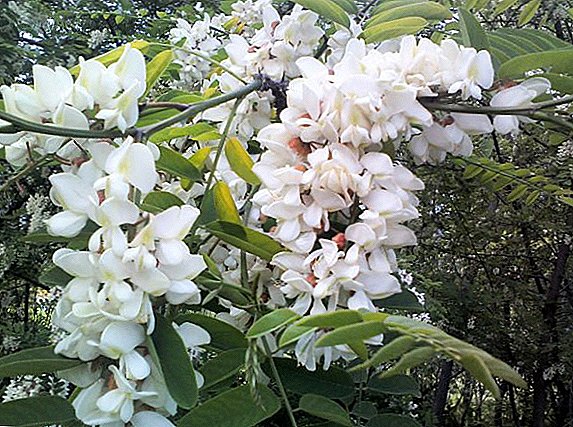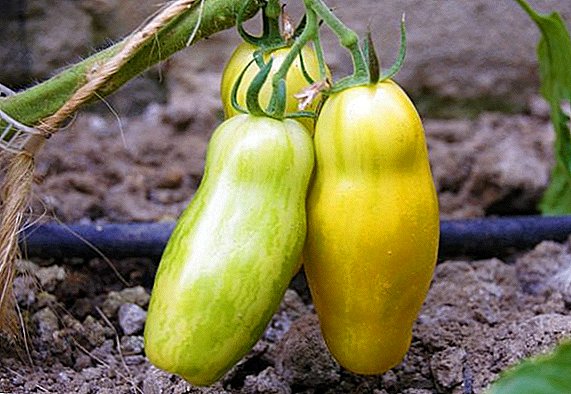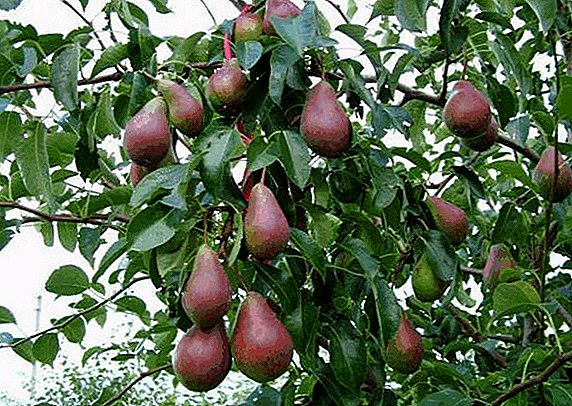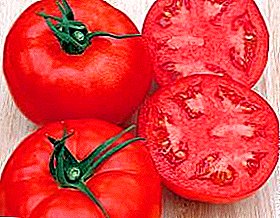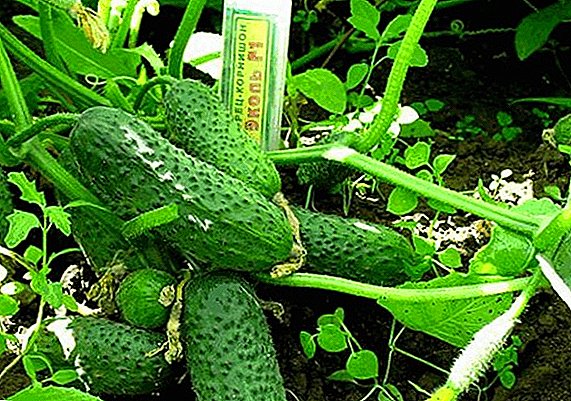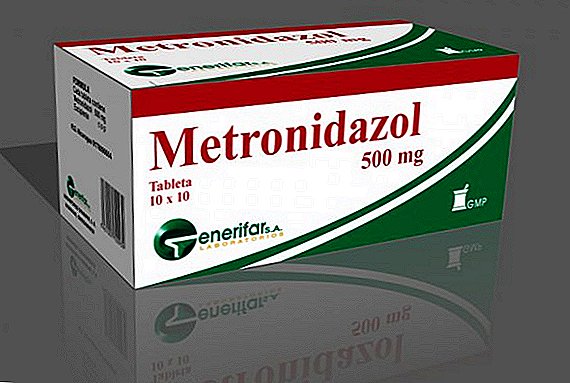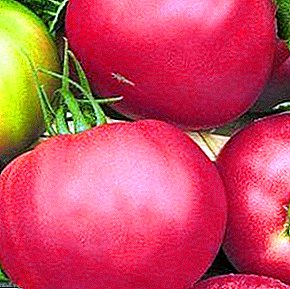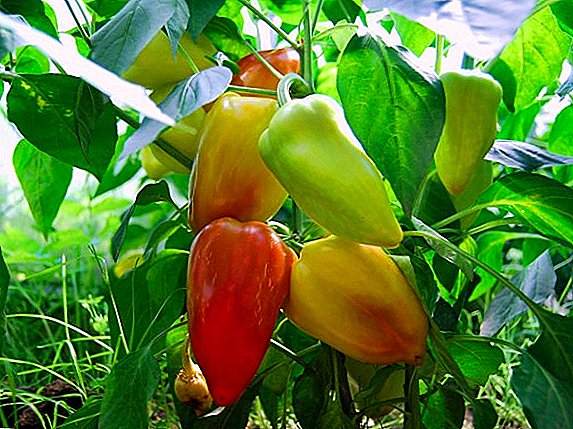 Pepper - heat-loving, southern plant, which came to us from Central America and managed to get along perfectly with the climate that was not quite familiar to them. What distinguishes the cultivation of pepper in the open field from the development of bushes in the greenhouse and how to make the bell pepper to please the eyes of the owners with their appearance and develop favorably in the beds, we will look into this article.
Pepper - heat-loving, southern plant, which came to us from Central America and managed to get along perfectly with the climate that was not quite familiar to them. What distinguishes the cultivation of pepper in the open field from the development of bushes in the greenhouse and how to make the bell pepper to please the eyes of the owners with their appearance and develop favorably in the beds, we will look into this article.
Growing conditions
Sowing seeds of pepper for seedlings can be from February (this is especially true for residents of apartments). This is done so that by the time of disembarkation (in May-June) the pepper has blossomed and has an ovary.  Before planting, the seeds must be processed as follows:
Before planting, the seeds must be processed as follows:
- Sprout pepper seeds (before swelling) in water at + 50 ° C for 5 hours.
- Place them in a damp cloth for 2–3 days before sticking. The temperature at which the pepper is processed should be at room temperature.

Did you know? The ideal temperature for pepper growth is + 27 ° C.The procedures carried out before planting the pepper are aimed at ensuring that you get the first shoots as early as 1-2 days after sowing.
It is important to remember that sweet pepper will grow well only if you buy high quality seeds. They will be able to provide you with a high yield.
If you want to achieve high yields, read when it is better to sow peppers for seedlings.To grow pepper seedlings, you need a substrate. Him desirable composition: humus, sand and earth (2: 1: 1). It is necessary that the soil was light, fluffy, loose. A good additive in this mixture will be ash, for 1 kg of the substrate will need only 1 tbsp. l

In February and March, seedlings need to provide additional coverage from 8 am to 8 pm. And so that the young pepper subsequently became more resistant to temperature changes and began to bear fruit earlier, the rest of the time, that is, from 8 pm to 8 am, the seedlings should be placed under an opaque fabric or material. Rassad at the time of such exposure should be less than a month.
Pepper before planting must be hardened. To do this, seedlings can be taken out on the balcony, each time increasing the time it is there.
Important! Temperatures up to + 13 ° С are too low for seedlings, so you need to carefully ensure that the peppers are not on the balcony during frosts - this can cause the plant to wilt.So the plant will be able to gradually get used to the effects of wind, sunlight, as well as temperatures below + 27 ° C.

Proper care after disembarking
In the middle-end of April, seedlings must be taken out in the greenhouse. There it should be covered with an oilcloth, which can be removed immediately after the ambient temperature rises above + 15 ° C. Pepper seedlings can not dive. Instead, you need to put it in boxes or glasses. It is important that the plant is under film.. If you planted the seeds of pepper even in winter, then after planting in the open ground the plant will bloom quickly enough, and the planting in the greenhouse must be made in early May.
Pepper can be planted in the event that on its stalk appeared sheets - from five to seven, at least. Before planting seedlings, the primer must be treated accordingly. Organic fertilizers can be added to the soil (about 5 kg per 1 square meter).
Did you know? Peppers can be planted in the ground, where they grew tomatoes, eggplants, potatoes, onions or cucumbers.It is also advisable to warm the ground by first placing arcs with a film over it.

Planted sweet pepper is best in a place protected from the wind. In this case, the plant should receive a sufficient amount of sunlight (if there are tall plants near the pepper that can shade it). Favorable time for disembarkation is the beginning of June.
The plant must be placed in the ground so that the earth reaches the first, lower leaf. The seedling should be under the film until the moment it takes roots, will not be fixed in the soil.
Important! Peppers of different varieties can not be planted close to each other. On the contrary, the distance between them is desirable to increase, because the pepper is prone to pollination.

Frost protection
As we said, pepper - heat-loving plant, therefore, even quenching will not make it resistant to low temperatures, but will only help to adapt and develop normally. Therefore, to ensure that the sweet pepper is always warm, it is necessary even after disembarkation. As a defense against the cold, the owners often use tents — cardboard, sackcloth, roofing felt or wooden bars are used to create them. Such devices help to protect seedlings from temporary, short-term frosts. For this tents put on top of seedlings at night. If the temperature is below + 15 ° C during the daytime, it is worthwhile to choose film shelters as protection against the cold weather.
There are two long-standing methods of protecting seedlings from cold weather - sprinkling and smoking.
Sprinkling implies the installation of a system that sprays water on plants. It works most efficiently when finely spraying water. It should be turned on late in the evening, and turned off closer to the morning, before sunrise.
Smoke This is the process by which the smoke of burnt materials envelops the plants. It is important to choose the right raw materials so that the smoke is thick. 
Watering plants
Sweet pepper can not be attributed to the drought-resistant plants. For favorable development, it requires watering. To seedlings better settled, it must be watered every 2-3 days. On one plant will need about 1.5 liters of water, and preferably watered at the very root.
Important! If the weather is dry, the pepper will need daily watering.A week after the landing of the pepper in the ground, it is necessary to replace it - plant new ones instead of dead plants. Watering them will need less water.
Despite the fact that the pepper consumes a considerable amount of moisture, it is very important not to overdo it with watering. Excessive amount of water is harmful to plants and can affect the quality and quantity of the crop. 
Novice gardeners sometimes do not know how often to water the peppers. The main sign that the bush needs moisture is the degree of darkening of the plant - it should darken completely. If you see this sign - you can safely water the seedlings. And it is desirable to do this immediately after you have seen the main sign of a lack of water in the plant, otherwise it may wither.
If the color is changed only the leaves of pepper, do not rush to take up watering. Thus, they react to hot weather, and you can inadvertently give the plant more moisture than you actually need and thus cause harm.
When the plant begins to bear fruit, you can water it less often. Once every 5 days will be more than enough. The most appropriate time of day to supply pepper with water is morning or evening. 
Weeding and loosening
Loosening the land - a necessary stage, without which the pepper will not be able to develop safely in open ground. Thanks to this action, a larger amount of air enters the roots, thereby accelerating the growth of the bush. In addition, loosening the soil activates the work of microorganisms that are in it, which also has a positive effect on the development of sweet pepper.
The plant has a superficial root system, that is, its roots do not go deep into the soil, but are fairly close to the surface. Therefore, it is necessary to carefully peack pepper in the open ground as much as possible so as not to damage the roots. And the pepper has quite thin stems, which can be touched if it is carelessly loosened.
To loosen the ground is not recommended immediately after planting pepper in open ground. To begin with, it is necessary to replace plants that have not taken root with others, and after that give them the opportunity to harden in the soil. The first soil treatment can be carried out approximately three weeks after the landing of the sweet pepper.
Important! If plants are gnawed before they are firmly fixed in the ground, there is a high probability of injury and lack of further development.

For the first time loosening the ground, carefully ensure that the tool does not enter the soil deeper than 5-10 cm. In the opposite case, there is a risk that you touch the root system of the pepper and soil treatment will not bring the expected positive impact on the development of the bush.
It is possible to loosen the ground deeper only if the soil in which the pepper is planted is heavy - this will enable the plant to get the necessary amount of air and heat. Loosening is not a process that should never be missed. It will be enough to walk along the rows after rains and irrigations. It is important that the ground at that time was not too wet, but did not even have time to dry. It is not necessary to work the soil every time, so if you do not have time to catch the desired soil moisture, you can safely transfer the procedure to the next time.
The number of such processing bushes depends not only on the frequency of watering or weather conditions, but also on the varieties of pepper. Thus, early varieties of soil treatment will take about 4 times, and later enough 2-3.
In the period when the pepper starts to bloom, you can use the spudger. 
Check out the most common varieties of sweet peppers: "California miracle", "Gypsy F1", "Bogatyr" and a variety of bitter pepper - "Habanero".
Fertilizer chart
Timely feeding - A very important condition for growing peppers in the open field.
It is not recommended to add fertilizer to the soil before planting pepper in it. You should wait for the plant to take root, and the first real leaves will appear on it. Then you can prepare the following solution: ammonium nitrate (0.5 g), superphosphate (3 g) and potassium fertilizers (1 g) are added to 1 liter of water. With repeated feeding (in two weeks) it is necessary to double the amount of mineral fertilizers.
For the third and last time, pepper is fertilized before planting the bush in a permanent place. This is best done 2 days before the final landing. Potash fertilizers this time will be 8 g per 1 liter of water. 
Did you know? Sweet pepper can be fed infusion of nettle in a ratio of 1:10.To start the cultivation of pepper, it is necessary to prepare the ground in advance - one year before planting the plant in the soil organic fertilizers are added - from 5 to 10 kg per 1 m². In the autumn it is good to add phosphate and potash fertilizers, each about 60 g in the lower layers of the soil. Top feed in the spring, which will require ammonium nitrate (40 g). Organic fertilizer in liquid form is also good to add to the soil.
Looking at the appearance of sweet pepper, you can easily determine what the plant lacks. So, if the leaves of the pepper curl, and on the edges shrink, it means that the plant lacks potassium.
Purple leaf color from the bottom, as well as their unnatural proximity to the trunk indicates a lack of phosphorus; in this case, the growth of bushes slows down, and fruit ripening is uneven. 
Small leaves, which are characterized by haze and light, sometimes even a gray tint indicate a lack of nitrogen, at the same time, when this element is oversaturated, the Bulgarian pepper drops ovaries and flowers.
Marble color of leaves - a sign of a lack of magnesium.
Important! It is undesirable to fertilize sweet pepper with potassium chloride - this substance does not give a visible effect and does not really affect the development of the plant.
Features of the formation of bushes
The formation of pepper bushes in the open field - a procedure necessary for tall varieties (the height of the bushes often reaches 2 meters). It is divided into four stages, each of which we describe in detail below. First of all, do not forget that you can only form those bushes that do not have diseases. The tool that you use during any of the stages of formation, must be sharp and clean. This is necessary so that during operation the plant is not subject to possible infection. Stage One bears the name "Crown Bud" and its essence is that this very bud in time to detect and rid of it sweet pepper. This part of the bush appears when it reaches a height of about 20 cm. At this time, the plant begins to branch, and in the place of the "divergence" of the branches, a part necessary for removal appears, which is called the "crown bud." It also happens that the flower does not appear alone. In this case, you should destroy all the buds, because they hinder the further development of pepper.
Stage One bears the name "Crown Bud" and its essence is that this very bud in time to detect and rid of it sweet pepper. This part of the bush appears when it reaches a height of about 20 cm. At this time, the plant begins to branch, and in the place of the "divergence" of the branches, a part necessary for removal appears, which is called the "crown bud." It also happens that the flower does not appear alone. In this case, you should destroy all the buds, because they hinder the further development of pepper.
Important! If the bud appeared before you planted the seedlings in open ground, you still need to get rid of it. Such an action in no way hurts the seedlings.The second stage of formation begins when the number of leaves in the bush reaches 10-12 pieces. At this stage, you will need to remove all unnecessary branches. Branches that look weak may subsequently affect the yield, so you can and should get rid of them (for this, the apical point of growth is removed). The remaining branches will become the so-called "skeleton" of the bush. That is why, during the second stage, weak branches are removed, or rather shortened. Thus you form a strong "frame" of the plant, able to bring a good harvest.

After that it is necessary to observe the further development of pepper. The branches that remain will begin to branch out. On each of them there will be a fork with a bud. And in order for the ovaries of the plant to get all the necessary nutrients, it is necessary to determine the strongest bud, while we get rid of the rest by pinching them above the first leaf. Such a manipulation is done every time the bush begins to branch. In the bud, which appeared on the ramification, later the pepper will be tied up (in tall varieties the number of ovaries varies from 17 to 25). Also removed those buds that have formed in the internodes.
To the third stage You can go after getting rid of the bush from the extra buds. Now the plant needs to get rid of barren shoots. They appear for the reason that even after the second stage of the formation of the bush, pepper does not stop developing.
At this stage, it is important to glance at the plants in order to notice unnecessary processes in time. It is easy to find them - they are all located below the branching point of the main stem. At the same stage, the sweet pepper bush must be rid of other unnecessary parts - leaves that are either damaged and, if not removed, can infect the whole bush, as well as those that create an additional and completely unnecessary shadow for pepper. Such leaves, as a rule, do not contribute to the nutrition of the ovaries. If this stage is neglected and leaves are left, then the fruit, no matter how it blooms, may not appear, which means the harvest from the bushes will be reduced.
To remove excess leaves, follow these rules. Leaf plates located on the main stem are cut when ripeness has reached the fruit of the lower brush. At the same time, only two sheets can be cut at a time. The second time you need to carry out this procedure when the second brush appears. The same rule applies to ripening fruits. The last time to get rid of extra sheets can be six weeks before the harvest. At this time, the bushes can not be touched, because they need to rest.
Fourth stage held in order to get a beautiful, tasty harvest. It is at this stage of the formation of bushes allowed the greatest number of errors. We will understand how to avoid them.
To make the pepper itself, which is eaten, large and have a pleasant taste, the plant needs strength. Therefore, it is very important to calculate them correctly. The energy of the bush goes to the development of new ovaries, and the main problem of novice gardeners is the fact that they leave more ovaries than the bush is able to “feed”. Thus, the strength of the plant, spent on the development of these same ovaries, subsequently lead to the fact that they all receive the same small amount of nutrients and cannot develop normally. The quality of the fruit, respectively, suffers. 
The maximum number of flowers on one bush is 25. New ones may appear after you save the plant from all unnecessary. That's when you need to start last stage - pinching kidneys. In order for the pepper to spend its strength on the development of high-quality fruits, you need to pinch all the growth points that are on the main branches. An important condition is the presence of ovaries on the bush, the number of which does not exceed the norm.
Only tall varieties of sweet pepper are subject to such careful formation. Другие же не требуют столько внимания - можно лишь избавить кусты от пустых побегов, чтобы перчик не расходовал на них полезные вещества, а также удалить листья, создающие дополнительную тень.
Основные проблемы при выращивании
Care for sweet peppers, as well as for any other crop, requires not only compliance with the rules of cultivation. Sometimes gardeners do not pay attention to some of the nuances, which can cause difficulties with the plant. Consider the main ones. 
Slow seed growth. Its main cause is a decrease in temperature below + 20 ° C. Warm climate is an important condition, because fluctuations in temperature adversely affect the development and growth of bushes. Gradually reduce the temperature when the seedlings become older than one month.
The technology of growing peppers in the open field requires greater attention to the plant, so many gardeners prefer to grow crops only in greenhouses.
Leaf fall can occur at once for several reasons, among which are: diseases, insufficient amount of moisture, low ambient temperature, soil depletion, aging. Also, the pepper reacts poorly to watering with very low temperature water. 
Find out what to do when the leaves of pepper seedlings turn yellow and fall.Shrinking plants often associated with several factors that are worth paying attention to. Pepper needs sunlight, a moderate amount of moisture and fertilizer, a stable warm climate (temperature differences adversely affect the health of the bush). Violation of these rules and leads to the fact that instead of a beautiful green plant, you will see a limp and painful. In addition, pepper can not bloom, which will lead to loss of harvest.
To sweet pepper bushes brought a good harvest, you should follow their timely watering, getting enough light, protect the plant from drafts and frosts, and also not overdo it with the addition of organic fertilizers to the soil, but at the same time keep the soil impoverished.
Sweet pepper is not an unpretentious plant. Cultivation and proper care for him in the open field will take a lot of time, but fruits rich in many trace elements and vitamins are definitely worth the effort spent on growing this crop.


